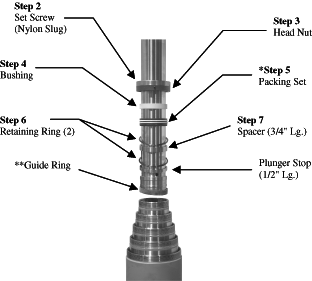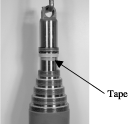Service
Dissassembly / Reassembly Instructions
Serial Numbers up to 399,999
Warning!
Before making adjustments or repairs to the cylinder when mounted in the unit, use strong, heavy, positive supports to hold the body from accidentally lowering. Place the cylinder valve in the "LOWER" position to ensure the pressure is relieved in the cylinder.
- We recommend field service repairs be limited to replacement of packing, bushings, wipers and adjustment of head nuts for leakage and proper sequencing.
- Before servicing the unit, check the plungers for damage. If the plunger is scored or scratched, smooth out marks with a fine stone or emery cloth to avoid damage to the new seals.
- After repair, a damp to light film of oil may be apparent on the plunger. A small accumulation of oil may be noticed on the plunger at the adjustable head nut after many cycles. This should not be mistaken for packing leakage.
- If a cylinder cannot be corrected by minor field repair, we recommend that the cylinder be returned to Custom Hoists®, or a factory qualified service dealer.
- If necessary to disassemble a cylinder due to a damaged part such as a plunger, the cylinder should be completely disassembled and all parts inspected. When requesting information or ordering parts, refer to the cylinder and serial numbers located at the base end of the cylinder. A Major Repair Kit should be installed when rebuilding the cylinder.
The following illustrations will serve as guide lines for the purpose of servicing a single-acting telescopic cylinder, and is intended to clearly show the essential steps to be taken for the complete disassembly. Remember! Use proper safety equipment.
Remember!
Use proper safety equipment.
- Parts Identification
The cylinder is best serviced mounted in the vertical position, for both disassembly and assembly. Also, it is best located where a hoist can be used directly overhead of the cylinder for removing the plungers if complete disassembly is required. A typical stand is shown in figure 1, made of angle welded to a base anchored to the floor and an adjustable wraparound chain to secure the cylinder to the stand. Because of oil spillage and safety, we recommend draining the cylinder of oil before disassembling. Lay the cylinder horizontally with the port down and open. Rotate the last plunger so the bleeder hole is on top and open. - Set Screws
All head nuts are secured to the plunger by a set screw. Under the set screw is a nylon slug to protect the plunger threads. To remove the head nut, the set screw must be loosened using an allen wrench. (Refer to Figure 3) - Head Nuts
After the set screws have been loosened, tap head nut gently around its circumference and unscrew the head nut with a chain wrench, or an equivalent tool. Do not use a chisel, punch or weld any studs to the head nut to remove. (Refer to Figure 4) - Bushings
Using a small chisel, tap gently upward with a mallet uniformly around the circumference of the bushing. (Refer to Figure 5) - Packing
To remove packing, pull the plunger up about one foot. Add tape to a clean area as shown in Figure 6. Push the plunger down past the packing then pull the plunger up. The packing will stick to the tape and be pulled out with the plunger. Repeat as needed. - Retainer Rings
Using a tool shown in Fig. 10, insert the hooked end into the retaining ring slot. Force the retaining ring partially out of the groove. With the second tool shown in Fig. 9 work the end of the tool under the end of the ring partially out of its groove. Working both tools together, unwind the retaining ring out of the cavity. (Refer to Figure 7) - Spacers
Using a tool shown in Fig. 11, insert the tool between the spacer and plunger. Hook the bottom of the spacer. As you lift the spacer, tap the plunger with a soft mallet and work the spacer up and out of the cavity. Repeat Step 6 to remove second retaining ring. The plunger is now free to lift out. The plunger stop will come out with the plunger. (Refer to Figure 8)
Reassembly of Cylinder
All bores in the packing area and plunger outside diameters must be free of tool marks and scratches. Polish with a fine paper, crocus cloth or a Scotch Brite pad. All parts should be clean and free of any contamination. A complete major repair kit is recommended. Drop all plungers into the body in the vertical position, as shown in Fig. 1. Assemble the remaining parts in the reverse sequence as listed in Fig. 2. The packing should be presoaked in oil before installing (do not use a detergent oil). Note, Fig. 2 for the direction of the packing. Using a tool similar to Fig. 9, seat each lip individually, making sure packing is nestled uniformly. After the head nuts are adjusted, make sure there is a nylon slug under the set screw before securing the head nut to the plunger. After installing the cylinder in the unit, open the bleeder screw and extend the cylinder to bleed the air. More than one extension may be needed to assure all the air is removed and cylinder operates smoothly.
Typical Tool End Shapes for Removing and Installing New Parts:

Figure 9
Used For: Removing Retaining Rings and Installing Packing (Figure 7)

Figure 10
Used For: Removing Retaining Rings (Figure 7)

Figure 11
Used For: Removing Spacer (Figure 8)
Serial Numbers up to 4000,000
Warning!
Before making adjustments or repairs to the cylinder when mounted in the unit, use strong, heavy, positive supports to hold the body from accidentally lowering. Place the cylinder valve in the "LOWER" position to ensure the pressure is relieved in the cylinder.
- We recommend field service repairs be limited to replacement of packing, bushings and wipers with initial setting of head nuts as described in this section.
- Before servicing the unit, check the plungers for damage. If the plunger is scored or scratched, smooth out marks with a fine stone or emery cloth to avoid damage to the new seals.
- After repair, a damp to light film of oil may be apparent on the plunger. A small accumulation of oil may be noticed on the plunger at the adjustable head nut after many cycles. This should not be mistaken for packing leakage.
- If a cylinder cannot be corrected by minor field repair, we recommend that the cylinder be returned to Custom Hoists, or a factory qualified service dealer.
- If necessary to disassemble a cylinder due to a damaged part such as a plunger, the cylinder should be completely disassembled and all parts inspected. When requesting information or ordering parts, refer to the cylinder and serial numbers located at the base end of the cylinder. A Major Repair Kit should be installed when rebuilding the cylinder.
The following illustrations will serve as guide lines for the purpose of servicing a single-acting telescopic cylinder, and is intended to clearly show the essential steps to be taken for the complete disassembly.
Remember!
Use proper safety equipment.
- Parts Identification
The cylinder is best serviced mounted in the vertical position, for both disassembly and assembly. Also, it is best located where a hoist can be used directly overhead of the cylinder for removing the plungers if complete disassembly is required. A typical stand is shown in figure 1, made of angle welded to a base anchored to the floor and an adjustable wraparound chain to secure the cylinder to the stand. Because of oil spillage and safety, we recommend draining the cylinder of oil before disassembling. Lay the cylinder horizontally with the port down and open. Rotate the last plunger so the bleeder hole is on top and open. - Set Screws
All head nuts are secured to the plunger by a set screw. Under the set screw is a nylon slug to protect the plunger threads. To remove the head nut, the set screw must be loosened using an allen wrench. (Refer to Figure 3) - Head Nuts
After the set screws have been loosened, tap head nut gently around its circumference and unscrew the head nut with a chain wrench, or an equivalent tool. Do not use a chisel, punch or weld any studs to the head nut to remove. (Refer to Figure 4) - Bushings
Using a small chisel, tap gently upward with a mallet uniformly around the circumference of the bushing. (Refer to Figure 5) - Packing, Wave Spring, Lower Bushing
To remove packing, wave spring and lower bushing, pull the plunger up about one foot. Add tape to a clean area as shown in Figure 6. Push the plunger down past the packing then pull the plunger up. The internal parts will stick to the tape and be pulled out of the plunger. Repeat as needed. - Retainer Rings
The retaining ring has a small hole at each end. Insert a pointed screwdriver to move the hole out into the I.D. Place a steel shim behind the retainer. Using the Custom Hoists' retainer ring tool, insert the points into the retainer and close the retainer against the tube. Pull the tube to remove the retainer and plunger stop. (Refer to Figure 7)
Reassembly of Cylinder
All bores in the packing area and plunger outside diameters must be free of tool marks and scratches. Polish with a fine paper, crocus cloth or a Scotch Brite pad. All parts should be clean and free of any contamination. A complete major repair kit is recommended. Drop all plungers into the body in the vertical position, as shown in Fig. 1. Assemble the remaining parts in the reverse sequence as listed in Fig. 2. The packing should be presoaked in oil before installing (do not use a detergent oil). Note, Fig. 2 for the direction of the packing. Using a tool similar to Fig. 9, seat each lip individually, making sure packing is nestled uniformly. After setting the head nuts (Step 7, Fig. 8), make sure there is a nylon slug under the set screw before securing the head nut to the plunger. After installing the cylinder in the unit, open the bleeder screw and extend the cylinder to bleed the air. More than one extension may be needed to assure all the air is removed and cylinder operates smoothly.
- Setting Head Nuts
Remove the small slug located opposite the set screw. Using a 5/32" hex wrench (as shown in Figure 8), tighten the headnut down until the hex wrench bottoms out on the top of the plunger. Remove the hex wrench and replace the slug. Install the set screw using a nylon slug to protect the threads.
Typical Tool End Shapes for Installing Packing:

Figure 9
Used for: Installing Packing
Are your needs unique?

Packing Set

Guide ring up to sn#349,999

Guide ring up to sn#350,0000










